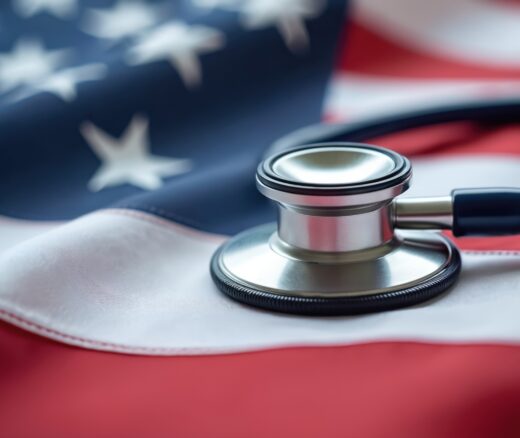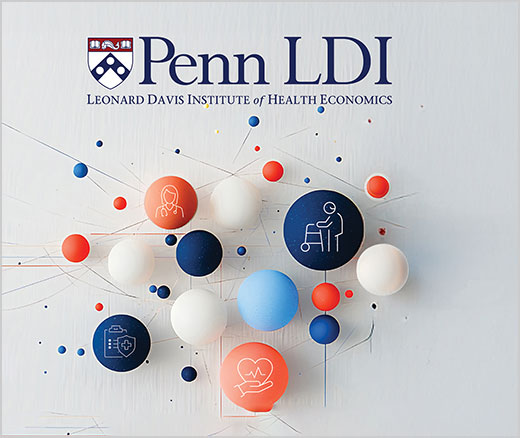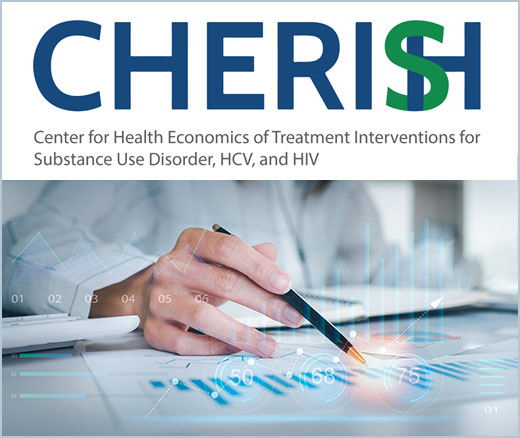
In the Loop or On the Loop: The Conundrum of AI Clinical Decision Support
2025 Penn Nudges in Health Care Symposium Focuses on the Human-Machine Interface
News

In 2022, when the U.S. Supreme Court overturned the long-standing constitutional right to abortion, it set in motion a sweeping array of changes that significantly affected the country’s health care system, judiciary, political landscape, health care, and reproductive rights of millions of Americans. Three years later, policymakers are still struggling to understand how all the ongoing, tumultuous changes will ultimately play out.
In its April 22 Health Impacts After Dobbs: What to Know and What Lies Ahead seminar, the University of Pennsylvania’s Leonard Davis Institute of Health Economics (LDI) brought together a panel of experts in fields heavily impacted by Dobbs to discuss the trajectory of these changes as they relate to health and health policies.
Moderated by Julia Hinckley, JD, LDI Director of Policy Strategy, the panelists were LDI Senior Fellow Alice Abernathy, MD, MSHP, Assistant Professor of Obstetrics and Gynecology at the Perelman School of Medicine; LDI Senior Fellow Ari Friedman, MD, PhD, Assistant Professor of Emergency Medicine at Perelman; and Dorothy E. Roberts, JD, Professor of Law and Sociology and Civil Rights at the Penn Carey Law School.

As she opened the session, Hinckley noted, “Emerging evidence is beginning to shed light on the health impacts of these policies ranging from infant mortality to maternal health outcomes, contraceptive access, and sterilization rates. Unfortunately, but not surprisingly, these effects have often not been felt equally. Women of color face greater financial and logistical barriers to accessing out-of-state care. As legal challenges to these bans and restrictions continue to make their way through the courts, we also anticipate additional new federal policy, adding further to the uncertainty.”
One of the surprises in the data discussed was that although the Dobbs decision was intended to decrease the annual number of U.S. abortions, it has actually increased them. In the year following Dobbs, the number of abortions rose by 11 percent, with medication abortion methods accounting for 63 percent of all procedures, according to the Guttmacher Institute.
“Abortion bans do not reduce demand for abortion—they just exacerbate preexisting inequities in who can access abortion, where, and when,” said Abernathy, whose research examines the links between constrained abortion access and maternal morbidity and mortality.
“Prior to the Dobbs decision, about 1 in 10 people left their state of residence to access abortion care,” Abernathy continued. “After Dobbs, that number is more like 1 in 5. In areas of the Southeast where the greatest number of contiguous states have enacted abortion bans, that can involve traveling upwards of 500 miles from some areas of Texas, Louisiana, and Mississippi. For some, that distance barrier is insurmountable, and access to telemedicine might not be possible either.”
Beyond the immediate access issue, health providers over the last three years have reported sharp increases in requests for sterilization, with some clinics seeing a doubling in tubal ligations among women ages 18 to 30 and a tripling in vasectomy requests among young men.
Currently, 14 states have implemented near-total bans on abortion, and seven others have enacted laws significantly reducing the time period in which individuals can legally obtain an abortion—frequently to periods so short that people are unlikely to even realize they are pregnant.
According to a 2024 JAMA study, only 11 of these 21 states include exceptions for rape and incest, but often require survivors to report the crime to law enforcement to be eligible for an abortion. This despite the fact that only a third of rape survivors are known to report their incident to the police. The study estimated that 64,565 rape-related pregnancies occurred between July 2022 and January 2024 in 14 states that implemented abortion bans, with the duration of the bans ranging from 4 to 18 months.

Meanwhile, as of April 2025, nearly every state-level abortion ban or restriction has faced or is undergoing legal scrutiny of various kinds.
“As a result of Dobbs, state law has become much more important because states can decide to allow or ban abortions,” said Roberts, the founding director of the Penn Program on Race, Science and Society, a MacArthur fellow, and a leading national expert in the fields of reproductive justice and bioethics. “That raises the question of how much power the states that ban or severely restrict abortions have over states that allow abortion. It’s no longer a question of ‘Does the U.S. Constitution protect abortion?’ but rather ‘Who gets to decide what law is the law that controls these questions?’”
A major area of clashing state interests focuses on whether law enforcement officials in a state that bans abortions can subpoena, prosecute, or extradite physicians in another state who provide services and abortion medication prescriptions to patients across state lines.
In 2025, 18 states that allow abortions have enacted various kinds of shield laws related to physicians’ provision of line-crossing abortion care. Ten of these states refuse to cooperate with out-of-state investigations, decline to extradite physicians, and prevent state agencies and medical boards from disciplining physicians for abortion work. They also protect physicians from civil lawsuits and criminal charges brought by out-of-state entities—but these protections do not apply if the abortion-related actions, such as the provision of abortion medications via telemedicine, occurred in another state.
The other eight of the 18 states with shield laws have enacted explicit protections for physicians who provide abortion care and prescribe medication across state lines.
This state-lines battle has come to focus intensely on out-of-state prescriptions for the abortion pill mifepristone, which is now used for 63 percent of all U.S. abortions. An anti-abortion group recently brought a case before the U.S. Supreme Court to revoke the Food and Drug Administration’s approval of the drug. The Court dismissed the case on a technicality, but central issues of related law remain unresolved and a continuing target for anti-abortion activists.
“The drugs mifepristone and misoprostol, which have become the subject of uncharacteristic and onerous regulatory requirements and a lot of litigation—even though they’re both completely safe and very effective,” said Abernathy. “Their centrality in a lot of this litigation really speaks to what the future of abortion probably looks like in the United States.”
The uncertainty of all this has left the overall legal status of abortion in flux across the country—a situation that heavily impacts and confounds the decision-making of newly pregnant people, often in ways that negatively affect their health and well-being.
Similarly, on the health provider side, news reports and scientific articles point out that clinicians—particularly emergency room physicians—are often caught in an impossible bind. They fear malpractice lawsuits if they fail to provide evidence-based care, at the same time they fear felony charges and license loss if they violate state bans that even cover procedures like miscarriage management.
Friedman, who is Co-Director of the Penn Digital Health Privacy Initiative, pointed out the many ways that the digital sphere of communications now enveloping society is increasingly playing into draconian measures anti-abortion activists are using to identify and target women who seek abortion information online. He explained how the personal data from countless apps and other digital structures used daily by millions is routinely sold to data brokers who market it to anyone willing to pay. Meanwhile, law enforcement and plaintiff attorneys can often subpoena it. This includes information from emails, web page visits, and from inside loosely built apps—including the popular ones many women use to monitor their biological stats and track their periods.
There are now more than 1,000 commercial apps collecting menstrual data on their users, including simple online period calendars and a wide range of fertility and reproductive health management tools.
“We now live in a world where we’ve built this incredibly powerful digital surveillance system that has never been used, even at a fraction of its full potential—and it’s growing all the time,” said Friedman. “In this kind of world of machine learning and big data, everything is potentially revealing of your health information, and that data is readily available to purchase—from the government, from data brokers, and from private citizens. For instance, Texas has created an enforcement mechanism that depends on data gathered by private citizens.”
“Electronic health record data is extremely protected but can be subpoenaed in medical malpractice lawsuits and accessed for legitimate law enforcement purposes,” Friedman said. “For instance, the Kentucky attorney general actually tried to use electronic health record data from another state to pursue people who may have traveled out of state to seek abortion care. Other researchers have warned that the entire system of regional health information exchanges and data sharing of electronic health records is now at risk because a few attorneys general want to use it to go after abortion patients with the full force of the law.”
Last year, U.S. Sen. Ron Wyden, D-Ore., issued a report detailing how anti-abortion activists bought phone location data from a data broker and used it to send misinformation to people whose other personal data indicated they had recently visited reproductive health clinics in 48 states. In another abortion prosecution case, Latice Fisher, a 32-year-old Black woman and mother of three in Mississippi, was charged with second-degree murder based in part on her phone’s Google search history. A grand jury ultimately declined to indict her.
Robert pointed to a non-obvious aspect of abortion bans. “Another of the bottom lines in all this is the likely increase in the forcible removal of babies from people who were compelled to give birth but were not prepared for it. This increases the daily struggles of already struggling families. Pregnancy Justice has found that more than 200 women have been prosecuted or punished in some way for pregnancy-related conduct since Dobbs. That’s what is likely to be increasing—the idea that the state should protect fetuses from the conduct of pregnant people with various forms of punishment, whether it’s prosecutions, confinement, or punishment afterward by taking the children from them. These are repercussions that are already happening. This is what Dobbs is doing to us.”



2025 Penn Nudges in Health Care Symposium Focuses on the Human-Machine Interface

Former Philadelphia Health Commissioner Warns That Gutting the CDC, Undermining Vaccines, and Politicizing Science Will Leave the U.S. Dangerously Unprepared for the Next Pandemic

Some Hospice Agencies Adjusted Admissions and Discharges to Maximize Payments

New Program Launches Research Initiatives Focused on Improving Primary Care for Older Adults

Rural Parents Had More Emergency Visits and Insurance Loss Than Urban Peers, an LDI Study Shows. Integrated Baby Visits Could Help All Parents Be Healthier

Penn and Four Other Partners Focus on the Health Economics of Substance Use Disorder